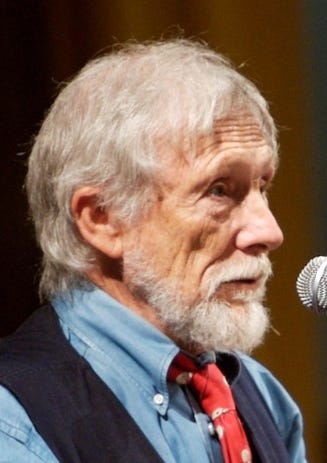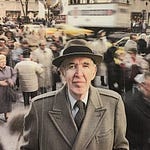He’s been called a poet of quiet revolution: a revolution staged to heal the rift between humanity and the natural world around us. Gary Snyder’s distinctive spirituality combines Eastern traditions like Zen Buddhism, Western concerns with deep ecology, and Native American wisdom.
Over his 94 years, Snyder’s career ranges from his early friendship with Jack Kerouac and the Beats, through his years in Japan studying Buddhism and Asian culture, followed by his acclaim as a kind of shaman of the counterculture and environmental movement.
Not a primitivist but a thinking poet, Snyder redefines humanism to include the nonhuman. By reconnecting with wilderness and practicing “reinhabitation,” we remember what Snyder notes was the role of the poet/shaman: to sing the voice of corn, the voice of the Pleiades, the voice of bison, the voice of antelope.
Some takeaways from our conversation:
A statement Snyder once wrote describing his work: “As a poet, I hold the most archaic values on earth. They go back to the late Paleolithic: the fertility of the soil, the magic of animals, the power-vision in solitude, the terrifying initiation and rebirth; the love and ecstasy of the dance, the common work of the tribe. I try to hold both history and wilderness in mind, that my poems may approach the true measure of things and stand against the unbalance and ignorance of our times.”
As the champion of an ethnopoetics which aims to recapture the primitive and give it voice, Gary Snyder models for us solidarity with a bioregion, with (as he put it) the classes Marx overlooked—the animals, rivers, and grasses.
His emphasis on the Buddhist notion of right livelihood and his appreciation of manual work: “A regular job ties you down and leaves you no time. Better to live simply, be poor, and have the time to wander and write and dig (meaning to penetrate and absorb and enjoy) what was going on in the world.”
Snyder does not belong to any particular poetic school but he can be said to come out of the modernist tradition of Ezra Pound and Charles Olson. This is poetry in a free form but also engaged with culture in a particular way. It was Pound’s translations from the Chinese which Snyder said inspired him to look into these poets.
His very local sense of bioregionalism: “Stewardship means, for most of us, find your place on the planet, dig in, and take responsibility from there—the tiresome but tangible work of school boards, county supervisors, local foresters—local politics.”
On his idea of “the practice of the wild”: “Off the trail is another name for the Way, and sauntering off the trail is the practice of the wild. That is also where—paradoxically—we do our best work. But we need paths and trails and will always be maintaining them. You first must be on the path, before you can turn and walk into the wild.”
Timestamps:
Intro clip: Gary Snyder reads a short poem about climbing the Sierra Matterhorn with Jack Kerouac.
00:45 Introduction of Snyder as a "poet of quiet revolution" bridging Eastern traditions and Western environmentalism
2:31 Pete and Elias discuss Gary Snyder as their first artistic prophet.
6:34 Early biographical details: Snyder's birth in San Francisco and childhood on a subsistence farm in Washington state
13:24 Snyder's early mountaineering experiences and spiritual connection to nature
21:24 Snyder’s involvement with the Beat movement and the historic San Francisco poetry renaissance
39:00 The relationship between Buddhist teachings and environmental consciousness in Snyder's work
42:39 Snyder's travels to Japan and deepening engagement with Zen Buddhism
49:00 Emergence of the environmental movement and Snyder's role in deep ecology
54:00 A reading of Snyder's influential "Smokey the Bear Sutra"
1:14:00 Snyder's concept of "re-inhabitation" and connection to place
1:22:00 Pete and Elias’ “field trip” to view one of the Chinese landscape scrolls that inspired Snyder at the Freer Gallery
1:35:00 Snyder's concepts of bioregionalism and deep ecology
1:42:39 Our guest, actor and author Peter Coyote, joins us to discuss his personal relationship with Snyder.
2:14:00 On the counterculture movement's successes and failures
2:17:14 Coyote's final thoughts on Snyder's legacy as a disciplined seeker of truth
2:25:30 Pete and Elias's final reflections on Snyder's Americanness and the unfinished project of the counterculture
Recommended:
Earth House Hold (1969)—prose selections, mostly related to “…the coming revolution [which] will close the circle and link us in many ways with the most creative aspects of our archaic past.” (Contains the essay “Buddhism and the Coming Revolution.”)
Turtle Island (1974)—a collection of poetry and prose which won the Pulitzer Prize for Poetry in 1975. Themes of rediscovery of the land and becoming native to it once again.
Practice of the Wild (1990)—perhaps Snyder’s most important essays on deep ecology and wilderness
Mountain and Rivers Without End (1996)—a long poem written over four decades, combining many themes from his work through the frame device of a Chinese handscroll
Distant Neighbors (2014)—Some 240 letters exchanged between Snyder and his friend from the 1960s, Wendell Berry
Dharma Bums (1958)—Jack Kerouac’s fanboy portrait of the young Gary Snyder, including their climb together up the Matterhorn mountain in the Sierras. The bubbling tone of their friendship, a crazy mix of proto-hippie freedom and Zen/Vedanta lingo, is kept up by Kerouac’s bebop prose style.
Sleeping Where I Fall: A Chronicle (1998, 2015)—Peter Coyote’s memoir of his epic days with the San Francisco Mime Troupe, the Diggers and the rising counter-culture
The Rainman’s Third Cure: An Irregular Education (2015)—Coyote’s second memoir, a collection of profiles of his mentors, including a Mafia consiglieri and poet Gary Snyder who introduced him to the practice of Zen
The Practice of the Wild (video of a talk Snyder gave at Colorado College in 2015).
Balaraswati Music and Dance School benefit reading—1976. Six minutes of Snyder, sitting in a lotus position and wearing beads, reading wonderfully from Regarding Wave and other collections.
Distant Neighbors, Festival of Faith (2014)—a live conversation between Snyder and Wendell Berry about their published collection of letters and the themes of their long friendship
Many thanks to the great band NOBLE DUST, who provides the music for Lost Prophets. Their latest album, A Picture for a Frame, is here.
Many thanks to our editor, the great Dan Thorn.
LOST PROPHETS is a podcast about the mid-century voices of solidarity we need to hear again. To listen on your podcast player, our Spotify link is here, Apple Podcasts link is here, and RSS link is here.















